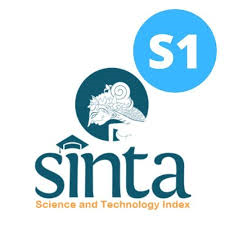Pandan (Pandanaceae) in Flores Island, East Nusa Tenggara, Indonesia: an economic-botanical study
Abstract
The people in the Indonesian province of Nusa Tenggara Timur (then East Lesser Sunda Islands) consist of many ethnic groups, each with their own local languages. The island of Flores is the second largest island within the East Lesser Sunda Islands. The island is inhabited by 10 ethnic groups, in which four are regarded as the dominant groups: Flores, Ende, Lio and Manggarai. The pandan flora of the island is still largely unknown; the same is for their ethnobotany. The aim of this current study is to know the traditional usages and potential uses of pandan flora in the Flores Island. The study was carried out in three regencies: Ende, Nagekeo and Manggarai. The result of this study shows that there are four species of Pandanus (P. amaryllifolius, P. dubius, P. kaernbachii, and P. tectorius) and one species of Freycinetia (F. insignis) are recorded from the areas understudy. The presence of P. kaernbachii in Flores Island is a new record. The people also recognises the diversity of Pandanaceae, especially from the genus Pandanus, in which they are known by local names such as “panda”, “re’a”, “waku”, and “mbojo”. Main usages of Pandanus are as material sources for handicrafts (mats, coffee bowls, and hats), dye, flavourings, funeral offering, and ornamental plant.
Keywords
Full Text:
PDFReferences
BAIRD, L. 2002. A Grammar of Kéo: An Austronesian language of East Nusantara. Australian National University, Canberra. [PhD. Thesis].
BERYBE. 2007. Seputar tiga kabupaten: Manggarai Barat, Manggarai Timur, dan Flores beserta kegiatan orang Manggarai di Jakarta, Lonto Leok, dan Tombokilo. [http: tombokilo.blogspot.com/2007/ripple-manggarai-three-in-one-sir.html].
BLUST, R. 2009. Is there a Bima-Sumba subgroup?. Oceanic Linguistics 47: 46–114.
DJAWANAI, S. A. 1980. A study of the Ngadha text tradition: A linguistic investigation of the collective mind of the Ngadha people on the island of Flores, Indonesia. University of Michigan, Michigan. [PhD. Thesis].
HIDAYAT, S., ASTUTI, I. P., MUNAWAROH, E & WIGHTMAN, G. 2001. Useful plants in the Luku Melolo forest, East Sumba, Indonesia. Indonesian Botanic Gardens and Parks, Wildlife Commission of the Northern Territory & Australian Centre for International Agricultural Research. Bogor.
HOFSTEDE, H. W. 1925. Het Pandanblad: Als Grondstof voor de Pandan hoeden industrie op Java. Eibergen, Batavia.
JEBB, M. 1992. A field guide to Pandanus in New Guinea, the Bismarck Archipelago & the Solomon Islands. Christensen Research Institute, Madang.
KANEHIRA, R. 1940. A summary of our knowledge of Papuan Pandanus. Bot. Mag. (Tokyo) 54: 258.
KEIM, A. P. 2009. Pandanaceae of the island of Yapen, Papua (West New Guinea), Indonesia, with their nomenclature and notes on the rediscovery of Sararanga sinuosa, and several new species and records. Blumea 54: 255–266.
KEIM, A. P, SUSIARTI, S. & AMIR, M. 2008. Taksonomi Pandanaceae Pulau Seram. Laporan Teknik Pusat Penelitian Biologi-LIPI: 1281-1326.
MC WHORTER, J. 2006. What we believe but can not prove. Harper, New York.
RAHAYU, M., SUNARTI, S. & KEIM, A. P. 2009. Kajian etnobotani Pandan Samak (Pandanus odoratissimus L. f.): Pemanfaatan dan peranannya dalam usaha menunjang penghasilan keluarga di Ujung Kulon, Banten. Biodiversitas 9 (4): 310–314.
RENSCH, B. 1930. Eine biologische reise nach den Kleinen Sunda-Inseln. Gebrüder Borntraeger, Berlin.
STONE, B. C. 1982. New Guinea Pandanaceae: First approach to ecology and biogeography. In: GRESSITT, J. L. (ed.). Biogeography and ecology of New Guinea. Vol. 1. Monographiae Biologicae 42. Dr. W. Junk Publ., The Hague.
STONE, B. C. 1983. A guide to collecting Pandanaceae (Pandanus, Freycinetia and Sararanga). Ann. Missouri Bot. Gard. 70: 137–145.
SUPARSA, I. N. 2009. The phonology of Rongga language: A transformational generative study. Udayana University, Denpasar. [PhD. Thesis].
SUSIARTI, S. & M. RAHAYU. 2010. Kajian Etnobotani Pandan Samak (Pandanus tectorius Sol.) di Kabupaten Tasikmalaya, Jawa Barat. Berita Biologi 10 (1): 113–122.
TEMU, S. T. 1995. Peranan tumbuhan dan ternak dalam upacara adat “Djoka Dju” pada suku Lio, Ende, Flores, Nusa Tenggara Timur. In: NASUTION, E. (Ed.). Prosiding Seminar dan Lokakarya Nasional Etnobotani II. LIPI & Perpustakaan Nasional: 263–268.
VAN BALGOOY, M. M. J. 1987. Collecting. In: DE VOGEL (Ed.). Manual of Herbarium Taxonomy Theory and Practice: 14 – 19. UNESCO.
WAWO, A.H. 1998. An ethnobotanical study of people around Ruteng Nature Recreation Park, Flores Island. In SIMBOLON, H. (Ed.). The Natural Resources of Flores Island. Research and Development Center for Biology, The Indonesian Institute of Sciences: 51–77.
WIRIADINATA, H. 2008. Flora Gunung Kelimutu dan Gunung Kelibara Taman Nasional Kelimutu, Pulau Flores, Nusa Tenggara Timur. Berita Biologi 9 (2): 185–194.
Refbacks
- There are currently no refbacks.









